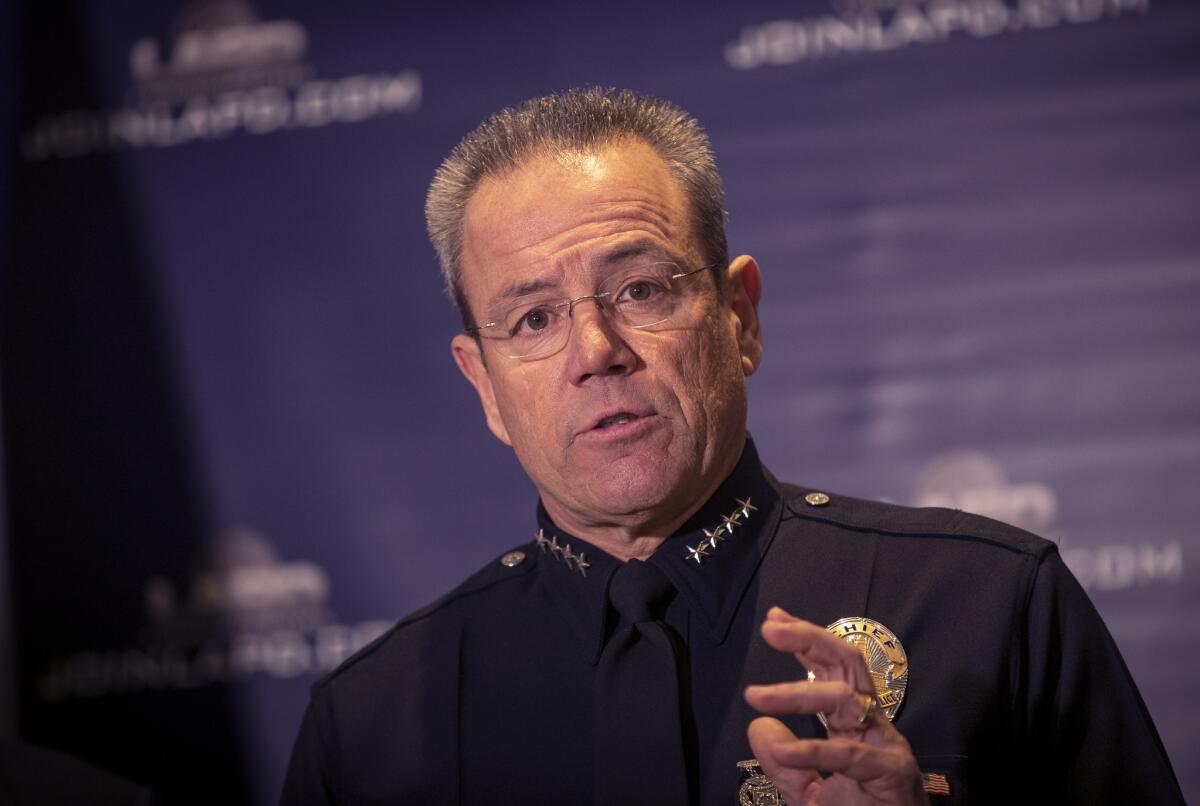LAPD Chief Moore points to pandemic as driving factor in increased gun violence, killings

- Share via
Los Angeles Police Chief Michel Moore said Tuesday that the COVID-19 pandemic has helped drive gun violence and increase killings in the city this year, including by spurring economic despair and interpersonal dramas while undercutting efforts to interrupt cycles of retaliation.
“What we’re sensing is a lot of stress, a lot of communities that are on edge, a certain amount of depression,” Moore said during a morning meeting of the civilian Police Commission.
In addition to serving as an emotional and economic wrecking ball, the pandemic, Moore said, has shifted nighttime gatherings away from traditional settings such as clubs and bars into neighborhoods and party houses, which have become a “fertile bed for some type of spontaneous violence.”
He also said that pandemic-related rules barring visitors from local hospitals have prevented trained violence intervention workers from visiting the bedsides of surviving shooting victims — eliminating the opportunity to provide resources and emotional support, address their anger and help prevent retaliatory violence on the streets.
“Those [programs] are being interrupted right now,” Moore said.
Moore’s comments follow a violent summer that saw gun violence increase in July and August. The trend has continued into this month, Moore said.
Earlier in the year, police had cited the pandemic as a cause for crime decreases, with fewer people on the street amid stay-at-home orders.
However, as of Sept. 5, homicides were up 13.7% compared with the same time last year, while the number of shooting victims was up 8.2%, according to the latest city data. Incidents in which shots were fired, including those in which no one was struck, were up 11.9%.
Compared with 2018, the increases were even more stark, with homicides up more than 20%.
The increases come despite a 5.6% drop in violent crime overall, and a 9.3% decrease in property crime despite a 35% increase in vehicle thefts.
They also come despite the lack of a parallel uptick in a more traditional driver of bloodshed in L.A.: gang-related violence. According to the Los Angeles Police Department data, shootings linked to gangs were down 14.4% compared with last year, and gang-related homicides were down nearly 2%.
Moore described L.A.’s increased violence this year as less severe than that seen in other major cities, including New York City, but said his commanders nonetheless view it as a top priority and have begun implementing changes to address it.
As one example, Moore said that officers in the department’s troubled Metropolitan Division who had been detailed to general crime suppression work have been redeployed onto shooting response teams, which are now assisting detectives by canvassing neighborhoods for information and following up with witnesses and victims.
Moore said the LAPD also is working with neighboring agencies to identify “what cross-neighborhood issues may be influencing this.”
The increased violence comes amid a wildly disruptive summer in a year of shocking upheaval in policing, one in which the LAPD has taken hits from all sides. While the killings increased, protests raged and the police budget was cut as elected leaders took up the increasingly mainstream concept of “defunding police” in earnest.
Moore and other leaders have been left to take stock, reviewing how the department operates and which units might be slimmed down in order to rein in spending and regain ground in the fight for public trust.
Supporters of the department have pointed to the uptick in violence as a clear reason to reverse course and “defend police” rather than defund them. But critics have questioned the correlation between police funding and crime reduction.
What is clear in the data is that the uptick in violence has corresponded with a decline in arrests.
Through Sept. 5, LAPD arrests in violent crimes were down 10.6% compared with the same time last year. Total LAPD arrests in the city were down more than 25% compared with last year, and down nearly 40% compared with the agency’s five-year average for total arrests at this point in the year.
There had been fewer than 44,000 arrests this year, as of Sept. 5, compared with more than 58,000 last year and a five-year average of nearly 70,000.
Stops of members of the public by LAPD officers were down more than 20% from last year, while calls for service were down just 3.9%.
The number of firearms recovered by police was down 27.2% this year, compared with last.
At the commission meeting, Moore was repeatedly asked about the recent $150-million cut to the department’s budget, and what the impact would be.
Moore noted that one previously identified result will be about 250 fewer sworn officers on the streets, but that additional effects are still being identified and could evolve if the department is subjected to additional budget or personnel cuts as the city continues to grapple with a growing fiscal crisis.
Moore said the department is committed to its core goals of reducing and solving violent crime, and that resources will remain devoted to those goals regardless of whether other responsibilities of police — such as responding to routine traffic collisions — get shifted to other agencies as public safety in the city is “reimagined.”
More to Read
Sign up for Essential California
The most important California stories and recommendations in your inbox every morning.
You may occasionally receive promotional content from the Los Angeles Times.











